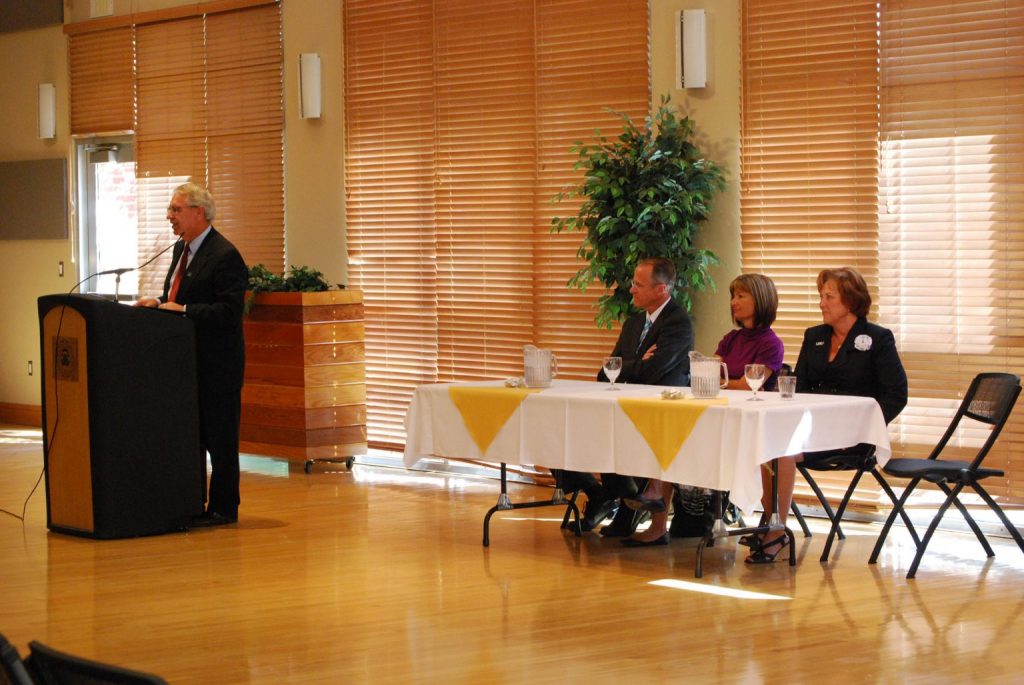USU President Stan Albrecht visits USU-CEU
Two important and noble institutions were formally brought together with the creation of Utah State University-College of Eastern Utah on July 1.
“Within a short period of time, there has been a large amount of progress in the transition. And as I meet with you today, I want you to know that I always feel at home when I come to the CEU campus, everyone is warm and genuine,” said Stan Albrecht, president of Utah State University, who came to the CEU Price campus Sept. 28 to discuss with faculty, staff and students about the changes taking place with the merger.

This archived article was written by: Valeria Moncada
Two important and noble institutions were formally brought together with the creation of Utah State University-College of Eastern Utah on July 1.
“Within a short period of time, there has been a large amount of progress in the transition. And as I meet with you today, I want you to know that I always feel at home when I come to the CEU campus, everyone is warm and genuine,” said Stan Albrecht, president of Utah State University, who came to the CEU Price campus Sept. 28 to discuss with faculty, staff and students about the changes taking place with the merger.
CEU already has easy access for two-year degrees, low-tuition rates, affordable living expenses and smaller classes. With the merger, students have access to earn a four-year graduate degree, increased opportunities to transfer to USU and access to its research and development programs.
Albrecht said some of the important milestones accomplished in a short amount of time include access to 50,000 electronic books and 40,000 academic journals; these numbers will continue to grow. USU has invested in two new electronic classrooms on the Price campus that have been equipped for broadcast capability that can expand the enrollment for the USU-CEU. Because of these types of classrooms, the USU-CEU social work classes already added enrollment and revenue to the Price campus. USU employees located in Price now have merged into the USU-CEU operation and are under the direction of Chancellor Joe Peterson.
The merger is providing funding from the legislature to do a number of important things like add new alarm and sprinkler systems, electronic courses and computer systems in the library. A bus tour from Logan to Price is planned in November so USU employees can visit the USU-CEU campus. This is a great opportunity for USU-CEU students to talk with the USU representatives.
“Representatives from a number of areas on the USU campus have been involved in evaluating and making recommendations in auxiliaries including housing, dining, bookstore and facilities. The fire marshal has looked at CEU’s fire alarms and hazardous waste.”
Some advantages for both campuses are that the enrollment numbers increased substantially. USU now has the largest enrollment in its 122-year history of the institution, not including the students who will be put into the account at USU-CEU. The Price campus also has a double-digit increase this year.
For the first time, the Logan campus has the largest education department in its history with 3,100 students. There has been a 51 percent increase in the entering freshman class within a four-year period. The first-time higher education students enrolled on the Logan campus account for 22 percent of the university’s enrollment, the transfer student rate is at 31 percent and returning students 34 percent. There are now more graduate students on USU’s regional campuses than on its main campus.
Albrecht said there are now $189 million for grants and contracts, which is a 29 percent increase from last year. There are 173 new scholarship endowments at USU. “No student who desires an opportunity for a higher education experience will be turned away.” The Logan campus has passed the $300 million mark in the $400 million campaign. A total of 21 new buildings have been added to the USU campus for education purposes with only three totally funded by the legislature.
He discussed partnerships that USU research and development is working on including using the facilities at WETC as a new potential revenue source, mine safety issues plus the energy resources of coal, natural gas, wind and solar. “The Eastern corridor of the state can be affected by new jobs and an economic future with this positive partnering with USU and CEU.” He hopes to announce two significant projects from this endeavor soon on the Price campus.
Some of the challenges that USU is facing in this most difficult economic period is budget cuts. “We have taken five significant budget cuts while trying to protect the core of the institution,” he said. The Logan campus cut $27.5 million or 17 percent from its base budget. The cuts have resulted in many places, for example, salary reductions, loss of staff and faculty, program eliminations and consolidations.
“I think it would be a major mistake for us to declare victory too early from the economic drop,” Albrecht said. Tuition is still a bargain and it may continue to climb higher, but should not have a major increase. “I worry about student debt, it has surpassed credit card debt in the United States. A lot of the student debt is to for-profit institutions of higher education. The state of Utah also has the lowest need-based aid in the United States.” Three brief principles Albrecht applies to his life are: first, remember you have to be willing to accept what happens, not what you want to happen. Secondly, just as you think everything is set, it all comes unglued again. And finally, be graceful and brave, to face the challenges and changes that will always come.




